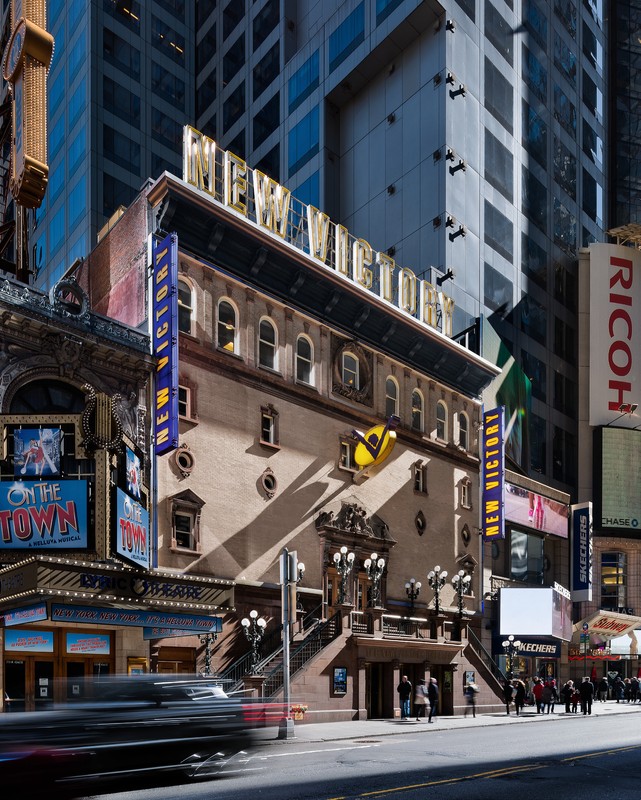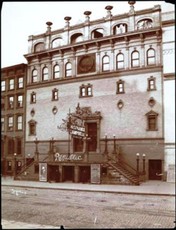New Victory Theater
Introduction
Text-to-speech Audio
Images
New Victory Theater (image from New Victory Theater Press Kit)

http://hatchingcatnyc.com/2014/05/

Backstory and Context
Text-to-speech Audio
Oscar Hammerstein built the Venetian facade of the Theatre Republic in 1900. The neighboring Victoria Theatre (also owned by Hammerstein) shared with the Theatre Republic the Paradise Roof Gardens, a miniature Dutch village. The village even included live ducks, chickens, and cows, whose fresh milk was provided to visiting children by a milkmaid. The interior dome of the Republic featured cherubs with lyres. Lionel Barrymore debuted in the Republic's opening performance, Sag Harbor.
David Belasco took over the Republic in 1902, renamed it after himself, and installed an orchestra pit, new lighting, and a modern stage with trap door features. He also installed a glass canopy at the entrance. Some notable performers at the then-Belasco Theatre included Mary Pickford, Lillian Gish, Tyrone Power, and George Arliss. Abie's Irish Rose, beginning its run at the former Republic in 1923, ran for 2,327 performances--the third longest run in the history of Broadway.
In the 1930s, Billy Minsky took over the venue, which was renamed Minsky's Republic. Minksy's was Broadway's first burlesque club, featuring Gypsy Rose Lee, among others. The venue was redecorated and the canopy replaced with a marquee. The center aisle was replaced with a double runway. Though the content of the shows was bawdy comedy, the dress code was Black tie. When Mayor LaGuardia banned burlesque in 1942, Minsky's was renamed The Victory, and the venue became a first-run film theater. The Times Square neighborhood declined throughout the ensuing decades, and The Victory became a pornographic movie theater in 1972.
The New 42nd Street (1990 - present)
As the neighborhood became more neglected and dangerous, the City and State of New York decided to redevelop the area. In 1990, the nonprofit organization, The New 42nd Street, was formed. Its goal was the revitalize the historic theaters of 42nd Street. The New Victory Theater was the first venue to be restored; architect Hugh Hardy's renovation cost $11.4 million and was completed in December of 1995. The Venetian facade, double staircase, and wrought-iron lamps from the Theatre Republic were restored, and the interior, though modernized for the convenience of families, still contains the original cherubs and one original lyre decorating the dome. Now, the New Victory Theater is a Broadway venue for children and families, offering theater, dance, circus, opera, and world music. The New Victory has won the National Arts and Humanities Program Award and Drama Desk Award for its performances and community outreach through school partnerships and summer workshops. Hands-on arts and crafts, acting, and dance activities are offered before and after shows.
Cite This Entry
Thagard, Gavin, Sara Marian, and Clio Admin. "New Victory Theater." Clio: Your Guide to History. April 18, 2019. Accessed March 30, 2025. https://theclio.com/tour/97/5/reverse
Sources
"About the New Victory Theater." The New Victory Theater. Accessed Web, 5/11/17. http://www.newvictory.org/About.

